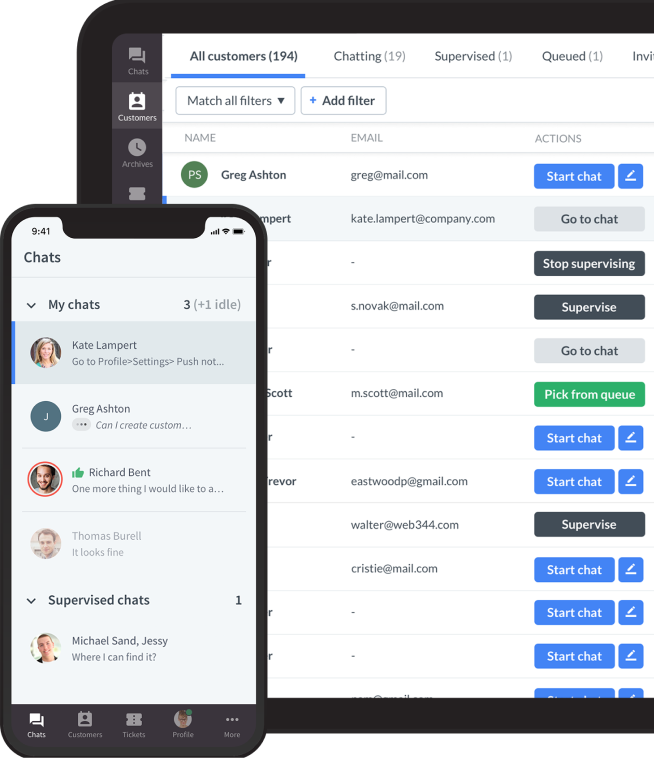Showing top 0 results 0 results found
Showing top 0 results 0 results found

Customer complaints are like alarm clocks for businesses - they're annoying and disruptive, but if you hit the snooze button, you'll be in big trouble. To maintain customer satisfaction, you need to address customer complaints promptly and effectively.
So, if you hear a customer complaint, don't hit snooze - wake up and make yourself some coffee because it's time to get to work!
What is a customer complaint?
A customer complaint is a form of feedback provided by a customer dissatisfied with a product or service offered by a business. It’s a way for customers to voice their disappointment and communicate their expectations for resolving the issue. They may be related to product defects, poor customer service, billing errors, shipping delays, and more. The good news is that it’s not always a bad thing.
Unhappy customers are your greatest source of learning
Every chat with an upset customer is something you wish never happened, right? But what if I tell you that you should be grateful for every customer complaint you have?
Customers are not keen on sharing their thoughts about your products or services. They will more likely complain on social media rather than contact you directly. In fact, for every customer who bothers to complain, 26 other customers remain silent! It means you get feedback from only a few dissatisfied customers, and the rest will give you another chance… or quietly walk away to a different business.
Look at it this way: someone using your product tells you where the problem is. It’s free information about what goes wrong and what can be improved. It also gives you an outside opinion regarding your company. Now it looks like an opportunity, not an obstacle that must be dealt with, right?
As Bill Gates once said, "Your most unhappy customers are your greatest source of learning." So don’t be afraid of unflattering feedback. Analyze customer complaints and do everything you can to increase customer satisfaction.

Four types of customer complaints
Let's look at the four types of customer complaints you can encounter in your business:
Product or service issues: This is one of the most common types of customer complaints. Customers may have issues with a product's quality, functionality, or usability. This can be due to a defect, an error in packaging or labeling, or a misunderstanding of how to use the product or service.
Billing or payment problems: Customers may complain about incorrect charges, unauthorized charges, or problems with refunds or cancellations. These issues can arise due to billing errors, system glitches, or miscommunication between the customer and support agents.
Shipping or delivery delays: Customers may complain about delays in receiving their orders or damaged or missing items. Logistical problems, shipping errors, or mishandling of packages can cause these issues.
Customer service experience: Customers may have complaints about the communication with customer service agents or their response time. They may feel that they were not listened to or that their issue was not resolved in a satisfactory manner.
Now, let's look at the strategies to effectively handle customer complaints and gain loyal customers.
Strategies for customer service teams to handle customer complaints
- Listen actively: When a customer makes a complaint, it's important to actively listen to their concerns and show empathy for their situation. This helps to diffuse the situation and show the customer that their concerns are being taken seriously.
- Apologize sincerely: Whether or not the business is at fault, it's important to offer a sincere apology (here's how to say something more than "sorry for the inconvenience"). This can help to build rapport and demonstrate that the business cares about the customer's satisfaction.
- Provide a solution: Depending on the nature of the complaint, businesses should offer a solution that meets the customer's needs. This may include providing a refund or replacement product, discount or coupon, or additional support or resources.
- Follow up: After providing a solution, it's important to follow up with the customer to ensure they are satisfied and address any remaining concerns. This helps build trust and ensure the customer remains loyal and satisfied.
- Learn from customer feedback: Customer complaints can provide valuable feedback on areas where your business may fall short, such as product quality or customer service. You should take this feedback to heart and use it to improve the operations and prevent similar complaints in the future.
These simple strategies can help you handle customer complaints and build customer loyalty. However, giving you plain strategies might not be enough to handle customer complaints effectively. We need to dig deeper and understand some customer behaviors to better respond to their needs. When communicating with a dissatisfied customer, choosing the right words is crucial to avoid making things worse.
How to talk to customers to avoid complaints
When people contact customer service teams, they always want to hear yes to all their requests. But that’s not always possible, is it? Nonetheless, you should avoid saying no to them. We all take denial very seriously. It can cause an emotional or even childlike response. Customers might shout (using caps lock) or threaten to leave your business. They are also quick to talk about it on social media – bad experiences are three times more likely to be shared than positive ones.
That’s why you should seek alternatives to flat-out saying no. Understanding the denial mechanism is key to approaching upset customers. It also helps you to deal with all types of difficult customers. To get the hang of it, let's quickly go back a couple of years to when we were little. After all, it started the first time our parents denied us candy.
In the book The Effortless Experience, Matthew Dixon, Nick Toman, and Rick DeLisi noted that when we were toddlers and one of our parents said NO, we had three options:
- Ask the other parent (we still had another chance of getting a yes).
- Accept no as the answer and forget about the case (but who wants to do that?).
- Cry, scream, and kick so that everyone can see our displeasure, hoping our outburst will change the decision (yes, we’ve all been there).
You probably think you outgrew this, but these reactions are still evident for most of us. We might not kick and bite as much, but we still scream and pout.
Here are some common refusal reactions adults have in customer service situations:
- Getting emotional – clients get angry and argue with customer service reps.
- Trying to talk to another agent - for example, by leaving the chat and returning later. This is the customer’s version of “asking another parent”.
- Asking to talk to the supervisor – customers are convinced that supervisors can bend the rules and are free to forget about the policy and procedures this one time only.
- Threatening to take their business to another company – customers rarely follow through with these threats though. It’s usually their inability to change things manifesting into these idle threats.
Regardless of which reaction you are faced with, they all can be damaging to your company because of the negative social media testimonials you can get after denying a request.
Remember that people are not themselves when they’re angry (or hungry). So how do you soothe the tempers of our customers without resorting to handing out Snickers bars? It’s all about attitude, knowledge, and the will to help.
Examples of how to say no to customers in a positive way
At some point, you will have to say no to customer requests or demands. Forgoing responses can cause customer frustration. To avoid that, you must approach the difficult matter of saying no more carefully. How do you do that?
1. Use positive communication
Each time you say no to a client, you're sending a message: "I don't want to help." Even if something can't be done, there's always a positive way to say it.
Let's say a customer of an online service wants to open a second account and you can’t do this unless they are a Premium Member. There are two ways to go about it:
a) No, you must be a Premium Member to have a second account. Right now you don’t fulfill the requirements.
b) Sure. Once you have a Premium Account you can run two separate accounts. Find out how to become a Premium Member here (link).
By going with the latter option, you don’t cut the conversation short and can show a possible way to end on a positive note. Remember, positive communication is the only communication you should use.
2. Find the closest solution
When you can't provide what your customers want, find the closest alternative. They'll still appreciate your effort even if it won’t work for them. This way you can minimize the number of angry customers.
Let's say a customer of an online store asks for a specific brand and you do not sell it. You might say:
a) I'm sorry, we don't sell this brand.
b) We don't sell it yet, but we have something similar that you might be interested in.
By providing an alternative, you can earn an otherwise lost sale. Keep in mind that your customer service team should know the product and its capabilities inside out to be able to suggest a substitute.
3. Provide a dedicated explanation
Not all of your customers can understand your product the same way. Some require a more detailed or simply different explanation to make a purchase. Understanding the customer's perspective is key.
Let’s say you’re a software provider, and a client is having difficulty implementing your software on the company website. You can approach this matter in two ways:
a) As long as you follow the tutorial instructions, it all should be fine unless you’re doing something wrong. Or maybe your site is not working properly.
b) Let’s follow the instructions together step by step. If it won’t work this time, I’ll ask my colleagues if there’s another way to do it.
Provide alternative ways of approaching a particular subject. If a customer needs an example, come up with one. If they prefer a step-by-step explanation, go for it. You can send customers knowledge base articles inside the chat and save yourself some time. Improving internal processes for such cases helps to resolve issues faster and minimizes the chances for customer complaints and their negative feedback.
4. Don’t let customers push you around
You can’t always give your clients the green light to their requests, no matter how badly you want it. If you have to refuse, make sure you are polite.
Let’s say a client wants to return an item after a long period of time, way past the normal return date. Since you can’t agree to that due to company policy, you have two options:
a) Due to the company’s policies, you can’t make a return. You exceeded the acceptable date. I’m sorry, there’s nothing I can do.
b) I understand your situation. I also spoke to my supervisor about your issue. But due to our company’s policy, I’m not allowed to accept it. I’m really sorry.
It’s not all about saying no or yes. It’s the impression you make that matters. Show the customer that you’ve thought about the situation and simply cannot fulfill the request. Instead of focusing on a customer’s mistake, try focusing on what you have done to help.
How to respond to customer complaints and requests
You can’t always say yes to every customer request. Learning to say no, and being subtle about it is an essential skill in customer service. It requires great self-control and self-awareness, but it’s a key to positive communication.
Remember that customers don’t stay forever just because you helped them out. However, they quickly leave when they feel you don't want to help.
Try to avoid a flat-out no. That’s not the message you want to send. Say what you need to say, but try to ease the pain of denial by suggesting alternative solutions.
Avoid recurring complaints and upset customers
One of the most important things you can do to avoid frequent complaints is to understand your customers' needs. To do this, it's worth conducting market research, engaging with your customers, and listening to their feedback. Then, it’s good to conduct user testing to identify any issues or areas for improvement. This will help you catch any problems early on and make sure that your product is as user-friendly as possible. Excellent customer support is also key. Ensure your support team has the right tools and knowledge to quickly resolve any issues your customers may have.
And last but not least, remember about effective communication and choosing the right words when handling customer complaints. By actively listening, responding empathetically, and focusing on solutions rather than problems, you can turn every negative experience into a positive one and build stronger customer relationships.
Get a glimpse into the future of business communication with digital natives.
Get the FREE report







Comments